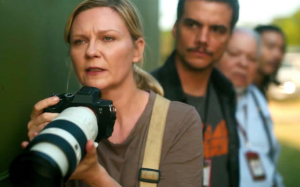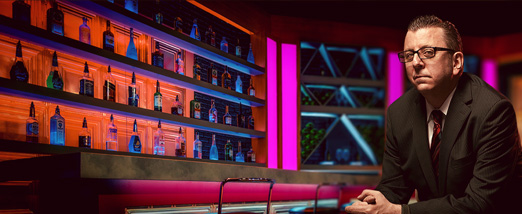CIVIL WAR: 4 STARS. “jarring, bravura and pulse-racing filmmaking.”
 “Civil War,” a new, near-future vision of dystopia from director Alex Garland, now playing in theatres, is an emotional and intellectual experience that plays like a stark prediction of what could happen if division and hate are allowed to run unchecked.
“Civil War,” a new, near-future vision of dystopia from director Alex Garland, now playing in theatres, is an emotional and intellectual experience that plays like a stark prediction of what could happen if division and hate are allowed to run unchecked.
At the film’s beginning the President of the United States (Nick Offerman) predicts victory for the American government over the separatist “Western Forces” led by Texas and California. In reality, the Second American Civil War is waning as the rebellious W.F. cut a path to Washington, while the “Florida Alliance” leaves a bloody mark on other parts of the country.
How bad is it? In the movie’s sole light moment, to Canadian audiences at least, it’s revealed that the Canadian dollar is more valuable, and more in demand than USD. That’s how bad the situation is.
In the midst of this, journalists capture the story on film and in words. Kirsten Dunst is Lee, a seasoned photojournalist, who with writer Joel (Wagner Moura) has an eye on getting the biggest scoop of the conflict, an interview with the President.
“Interviewing him is the only story left,” she says.
As Lee and Joel, along with veteran New York Times journalist Sammy (Stephen McKinley Henderson) and ambitious combat photographer Jesse (Cailee Spaeny), set off on the 857-mile journey from New York to D.C., the full impact of the war’s destruction, on property and people, becomes clear.
“Every time I survived a war zone, I thought I was sending a warning home, ‘Don’t do this,’” Lee says, “but here we are.”
There are no monsters or supernatural aspects in “Civil War,” but make no mistake, this is a horror film. The horrors of war are detailed in a visceral and chaotic way—the rat-a-tat-tat of gun battles is deafening, while the cinema verité style shots of carnage and bodies left abandoned to rot in the sun stick in the imagination—but it is the idea of a societal collapse that haunts. “No one is giving orders,” says a soldier. “Someone is trying to kill us, and we’re trying to kill them.”
Garland uses thrilling, in-your-face imagery that brings to mind everything from classic war films to the handheld coverage of the Capitol attack of January 6, 2021 to paint a portrait of a country in combat with itself.
The director, who also wrote the script, is decidedly non-partisan in his approach to the story, emphasizing the cruelty of the movement, and the actions of the extremist militias, not the politics. In this version of civil war, the population are divided by ideology. Friends turn on friends, state on state, and wearing an orange “Press” Kevlar vest won’t keep the journalists safe. “They shoot journalists on sight at the capitol,” says Sammy. The ravages of this war, set against ordinary backdrops, like an abandoned Christmas theme park, or a deserted highway, are unsettling in a profound, unnerving way.
The jarring visuals—an opening protest scene is a jaw-dropper—enhanced by a pulsating, anxiety inducing electronic soundtrack are almost overwhelming, but underscore the importance of the journalists who risk their lives to record history in real time. The occasionally shocking situations and images—the final shot is a doozy, provocative and bound to be controversial—are powerful reminders of the risks undertaken by reporters on the search for the truth.
That risk factor, at a time when journalism is under fire, is highlighted in “Civil War,” but takes a backseat to Garland’s bravura, pulse-racing filmmaking.
